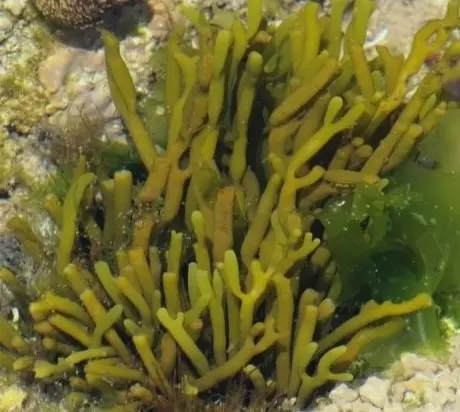
Bifurcaria bifurcata
weeks

Typical applications: Bifurcaria bifurcata
Typical applications
Traditional Uses
Historically, Bifurcaria bifurcata has been used in traditional practices, including as a fertilizer due to its nutrient-rich composition.
Potential Health Benefits
It contains bioactive compounds, including polysaccharides and antioxidants, which are being researched for their potential health benefits, including anti-inflammatory and antimicrobial properties.
Aquaculture and Animal Feed
The algae can also be used in aquaculture as a food source for herbivorous fish and as a supplement in animal feeds.

ALGANEX certificate system
Product information: Bifurcaria bifurcata
Bifurcaria bifurcata, commonly known as the forked wrack or forked algae, is a type of brown algae belonging to the family Dictyotaceae.
Key Characteristics
Appearance: This seaweed is notable for its distinctive forked or branched fronds, which can grow up to 1 meter long. The fronds are usually dark brown to olive-green in color and have a leathery texture.
Habitat: Bifurcaria bifurcata is typically found in shallow coastal waters, often attached to rocks or other substrates in the intertidal and subtidal zones. It thrives in areas with strong water movement, such as rocky shores and tidal pools.
Distribution: It is primarily distributed along the Atlantic coasts of Europe, including areas like the British Isles, as well as parts of North Africa and the Mediterranean Sea.
Ecological Importance
Habitat Provider: Bifurcaria bifurcata provides habitat and food for various marine organisms, including small fish, invertebrates, and grazers. It contributes to the overall biodiversity of coastal ecosystems.
Stabilization: The plant’s holdfasts help stabilize the substrate, reducing erosion and promoting the growth of other marine flora.
What are the primary characteristics and appearance of Bifurcaria bifurcata?
Bifurcaria bifurcata, commonly known as forked wrack, is a brown algae characterized by its distinctive forked or branched fronds, which can grow up to 1 meter long. The fronds are typically dark brown to olive-green in color and have a leathery texture, allowing them to withstand strong water currents.
How does Bifurcaria bifurcata contribute to coastal ecosystems and marine biodiversity?
Bifurcaria bifurcata provides habitat and food for various marine organisms, including small fish, invertebrates, and grazers. It contributes to biodiversity by stabilizing the substrate, reducing erosion, and offering shelter for numerous species in coastal environments.
What nutritional components does Bifurcaria bifurcata contain, and how can it be beneficial for human consumption?
Bifurcaria bifurcata is rich in vitamins, minerals, and polysaccharides, which may provide health benefits. Although it is not widely consumed as food, its nutritional profile suggests potential use in supplements or as a natural food ingredient due to its beneficial compounds.
What are the traditional uses of Bifurcaria bifurcata in local cultures?
Traditionally, Bifurcaria bifurcata has been used in coastal communities as a natural fertilizer, leveraging its nutrient-rich composition. It may also have been utilized in various traditional dishes or as a source of food for livestock.
Can extracts from Bifurcaria bifurcata be used in skincare or cosmetic products, and what benefits do they provide?
Yes, extracts from Bifurcaria bifurcata can be used in skincare products for their hydrating and antioxidant properties. The bioactive compounds may help protect the skin from oxidative stress and provide moisturizing benefits.
What bioactive compounds are present in Bifurcaria bifurcata, and what health benefits are associated with them?
Bifurcaria bifurcata contains various bioactive compounds, including polysaccharides and antioxidants, which may exhibit anti-inflammatory and antimicrobial properties. Research suggests these compounds could support immune health and protect against oxidative damage.
How is Bifurcaria bifurcata used in aquaculture, and what role does it play in fish diets?
In aquaculture, Bifurcaria bifurcata serves as a natural food source for herbivorous fish. Its nutritional profile can enhance fish diets, providing essential vitamins and minerals that promote growth and health in aquaculture settings.
What environmental factors influence the growth and distribution of Bifurcaria bifurcata?
Growth and distribution of Bifurcaria bifurcata are influenced by factors such as water temperature, salinity, light availability, and wave action. It thrives in shallow, nutrient-rich waters where there is sufficient light and water movement.
Are there any medicinal applications or therapeutic benefits linked to Bifurcaria bifurcata extracts?
Research into Bifurcaria bifurcata suggests it may have medicinal applications due to its bioactive compounds. Potential benefits include anti-inflammatory effects and support for skin health, although more studies are needed to confirm these applications.
How can Bifurcaria bifurcata be sustainably harvested and used in coastal regions?
Sustainable harvesting of Bifurcaria bifurcata involves careful collection methods, such as cutting fronds instead of uprooting plants. Regulations and guidelines in coastal regions help ensure that harvesting practices do not deplete local populations or disrupt the ecosystem.
Sources
- Horta A, Pinteus S, Alves C, Fino N, Silva J, Fernandez S, Rodrigues A, Pedrosa R. Antioxidant and antimicrobial potential of the Bifurcaria bifurcata epiphytic bacteria. Mar Drugs. 2014 Mar 24;12(3):1676-89. doi: 10.3390/md12031676. PMID: 24663118; PMCID: PMC3967231. (https://pubmed.ncbi.nlm.nih.gov/24663118/)
- Smyrniotopoulos V, Merten C, Firsova D, Fearnhead H, Tasdemir D. Oxygenated Acyclic Diterpenes with Anticancer Activity from the Irish Brown Seaweed Bifurcaria bifurcata. Mar Drugs. 2020 Nov 23;18(11):581. doi: 10.3390/md18110581. PMID: 33238388; PMCID: PMC7700283. (https://pubmed.ncbi.nlm.nih.gov/33238388/)
- Silva A, Carpena M, Cassani L, Grosso C, Garcia-Oliveira P, Delerue-Matos C, Simal-Gandara J, Barroso MF, Prieto MA. Optimization and Bioactive Evaluation of Bifurcaria bifurcata Antioxidant-Rich Extracts for Functional Food and Pharmaceutical Applications. Antioxidants (Basel). 2024 Sep 30;13(10):1189. doi: 10.3390/antiox13101189. PMID: 39456443; PMCID: PMC11505410. (https://pubmed.ncbi.nlm.nih.gov/39456443/)
- Martínez MA, Aedo H, Lopez-Torres B, Maximiliano JE, Martínez-Larrañaga MR, Anadón A, Martínez M, Peteiro C, Cueto M, Rubiño S, Hortos M, Ares I. Bifurcaria bifurcata extract exerts antioxidant effects on human Caco-2 cells. Environ Res. 2023 Aug 15;231(Pt 1):116141. doi: 10.1016/j.envres.2023.116141. Epub 2023 May 13. PMID: 37187306. (https://pubmed.ncbi.nlm.nih.gov/37187306/)
Reply within twelve hours